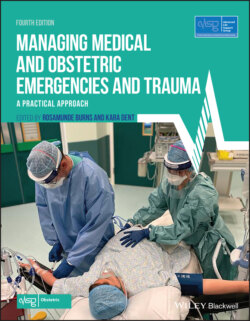Читать книгу Managing Medical and Obstetric Emergencies and Trauma - Группа авторов - Страница 138
7.6 Monitoring, investigations and urgent treatment
ОглавлениеMonitor women who have red and amber flags with suspected sepsis continuously and record using a MEWS chart (NICE, 2016). The conscious level should also be monitored using ACVPU (alert, new confusion, responds to voice, responds to pain, unconscious). A sepsis care bundle must be applied in a structured and systemic way with urgency. The time to administration of antibiotics is a predictor of mortality in sepsis, do not delay and use local antibiotic prescribing guidance. Antiviral medication may also be appropriate. The woman must be continually reassessed and senior review is essential. Consider ‘declaring sepsis’, analogous to activation of the major obstetric haemorrhage protocol.
The UK Sepsis Trust recommends the Sepsis Six (Algorithm 7.1) with all actions to be completed within 1 hour.
You can think of it as:
‘3 in, 3 out”: fluids, antibiotics and oxygen in / catheter, lactate and blood cultures out.
Initial blood tests include lactate – either arterial if there is evidence of hypoxia or a venous sample. Any woman in whom sepsis is suspected, who has a lactate >2 mmol/l, needs to have resuscitation started immediately. Raised serum lactate is a marker for poor perfusion and tissue hypoxia from whatever cause and signifies severe illness.
Additional blood tests include blood cultures, full blood count, coagulation screen, urea and electrolytes, blood glucose, liver profile and C‐reactive protein (CRP). Consider urinalysis, urine for culture, sputum culture, vaginal swabs, breast milk culture and throat swabs. Consider a chest x‐ray in all with suspected sepsis. Consider imaging of the abdomen and pelvis if no likely source of infection is identified after clinical examination and initial tests.
